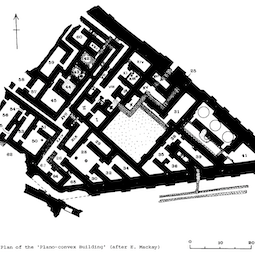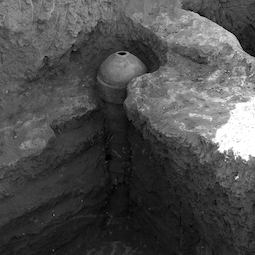The Plano-Convex Building: An Administrative Building in Area P
In 1923-1924, the OFME discovered a large building north of Tell Ingharra, entirely made of plano-convex bricks — that is, bricks with one flat, rectangular surface and the other surfaces curved. Unable to assess the nature of this structure, the team simply named it the "Plano-convex Building", after the shape of its bricks, and called the area "Area P". Its Arabic name is Umm al-Dhahab, "Mother of Gold", suggesting that local people have regularly discovered ancient coins, jewellery or other precious objects there (Gibson 1972: 119).
 [/kish/images/pcb-fig1-large.jpg]
[/kish/images/pcb-fig1-large.jpg]1. Plan of the Plano-convex Building, based on Ernest Mackay's unpublished materials (Moorey 1978: 35)
The OFME's published reports barely mention this find. It is known thanks to Roger Moorey's extensive study of the OFME's unpublished index cards (Moorey 1978: 34-47). Moorey also discovered that a partial plan of the site had survived among the Kish records of the Field Museum of Chicago, together with a set of negatives (Moorey 1978: 34). Archaeologists now consider Area P to be one of the most important areas at Kish/Hursagkalama, as it provides evidence of a major urban settlement from the Early Dynastic period (Gibson 1972: 76).
Between November 1923 and January 2024, the OFME made quick progress, first uncovering a series of rooms on the northwest side of a large courtyard, and quickly reaching more rooms and an entrance complex and courtyard (rooms 40 and 41). By the end of this first season, they had also found drains and a buttressed wall, as well as the remains of roofing and of a pavement covered in bitumen (Moorey 1978: 35). Rectangular buttresses to a height of 150cm and a substantial external wall also remained around the whole building.
Archaeologists could tell that the building seemed to have flourished in the Early Dynastic Period IIIa-b (c. 2540-2350 BC), and was probably deserted sometime in after period IIIb, but what was it used for? Although dated to the same period as Palace A, the Plano-convex Building had none of the monumental features of Palace A, and it did not seem to have been used as a religious complex. This was an elite building (Zaina 2015), but what kind, and whose?
 [/kish/images/pcb-fig2-large.jpg]
[/kish/images/pcb-fig2-large.jpg]2. "Water drain in building". Source: OFME Photo Album, ANT 140, p. 86, negative number 3591. (Note: this photo does not specify if the building was Palace A or the Plano-Convex Building.)
Another important question remains to be answered: why was water used so extensively in this building, and how? Many bitumen lined basins were found in the rooms, and rooms lined with wood ("wainscotted rooms" in Moorey's words) were also coated with bitumen. The flow of water was carefully managed, not only through the drainage system which still survived in parts, but also by a well below ground which seems to have provided an independent supply of water within the walls.
Few objects were found during the excavation of the Plano-convex Building. Fragments of inlays which had decorated the walls were discovered in many rooms, some made of shell. A cylinder seal was also found on the southern side of the great court, carved with "a man paddling a boat" (Moorey 1978: 37). A headless statue was also found in the well (room 40). It closely resembles statues representing seated women, discovered in the Diyala region of Iraq, which also depict women holding a pointed cup and a plant, probably a palm fan (Moorey 1978: 41)
15 Aug 2025
Nadia Aït Saïd-Ghanem
Nadia Aït Saïd-Ghanem, 'The Plano-Convex Building: An Administrative Building in Area P', The Forgotten City of Kish • مدينة كيش المنسية, The Kish Project, 2025 [http://oracc.org/MoundsofKish/Plano-ConvexBuilding/]